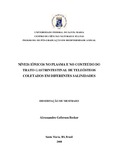| dc.creator | Becker, Alexssandro Geferson | |
| dc.date.accessioned | 2010-11-30 | |
| dc.date.available | 2010-11-30 | |
| dc.date.issued | 2008-02-12 | |
| dc.identifier.citation | BECKER, Alexssandro Geferson. ION LEVELS IN THE PLASMA AND GASTROINTESTINAL TRACT
CONTENT OF TELEOSTS COLLECTED IN DIFFERENT SALINITIES. 2008. 82 f. Dissertação (Mestrado em Ciencias Biológicas) - Universidade Federal de Santa Maria, Santa Maria, 2008. | por |
| dc.identifier.uri | http://repositorio.ufsm.br/handle/1/5267 | |
| dc.description.abstract | Seawater teleost fish are hyposmotic to their environment and as a consequence must deal with a constant diffusive loss of water and a net gain of salts. In contrast to living in seawater, teleosts fish in a freshwater environment are faced with the opposite dilemma, a
constant osmotic influx of water and depletion of salts. Between these environments there are estuarine regions, which are habitats of several species. The purpose of this study was to investigate Na+, Cl-, K+, Ca2+, and Mg2+ levels in the fluid phase and total amount of the
contents of the segments of the gastrointestinal tract and plasma of freshwater and estuarine teleosts collected in different salinities (0 to 34 ) in the São Gonçalo channel in Pelotas, southern Brazil. Moreover, a possible relationship between the ion levels and salinity was
investigated. After capture of the fishes, blood was collected and specimens were sacrificed for removal gastrointestinal tract segments: stomach, pyloric ceca/anterior intestine, mid- and posterior intestine. The results showed that there was no relationship between ion levels in the plasma, in the fluid phase and in the total amount of the segments of the gastrointestinal tract
with salinity when considering all species together, but species (Micropogonias furnieri and Netuma barba) collected in three or more salinities demonstrated significant relationship of these parameters with salinity. The ion levels in the fluid phase and total amount of the most species showed significantly higher values in the anterior intestine than stomach. Moreover,
ion levels showed a variation throughout the gastrointestinal tract suggesting possible ion
absorption. These results suggest that the change of salinity affected ion levels in the plasma and in the content of the gastrointestinal tract of Micropogonias furnieri and Netuma barba, indicating that this system might be related with osmoregulation of these species. | eng |
| dc.description.sponsorship | Coordenação de Aperfeiçoamento de Pessoal de Nível Superior | |
| dc.format | application/pdf | por |
| dc.language | por | por |
| dc.publisher | Universidade Federal de Santa Maria | por |
| dc.rights | Acesso Aberto | por |
| dc.subject | Estuários | por |
| dc.subject | Fluidos intestinais | por |
| dc.subject | Osmorregulação | por |
| dc.subject | Peixes de água doce | por |
| dc.subject | Peixes de água salgada | por |
| dc.subject | Salinidade | por |
| dc.subject | Trato gastrintestinal | por |
| dc.subject | Estuaries | eng |
| dc.subject | Freshwater fish | eng |
| dc.subject | Gastrointestinal tract | eng |
| dc.subject | Intestinal fluids | eng |
| dc.subject | Osmoregulation | eng |
| dc.subject | Salinity | eng |
| dc.subject | Seawater fish | eng |
| dc.title | Níveis iônicos no plasma e no conteúdo do trato gastrintestinal de teleósteos coletados em diferentes salinidades | por |
| dc.title.alternative | Ion levels in the plasma and gastrointestinal tract content of teleosts collected in different salinities | eng |
| dc.type | Dissertação | por |
| dc.description.resumo | Peixes teleósteos adaptados à água do mar são hiposmóticos em relação ao meio em que vivem e como conseqüência disso convivem com uma constante perda de água por osmose e ganho de sais por difusão. Ao contrário dos teleósteos que vivem na água salgada, peixes teleósteos adaptados à água doce convivem com o dilema oposto, uma constante
entrada de água por osmose e perda de íons por difusão. Além disso, entre esses ambientes existem as regiões estuarinas, as quais são habitats de várias espécies. A proposta desse
estudo foi investigar os níveis de Na+, Cl-, K+, Ca2+ e Mg2+ na fase fluida e quantidade total do conteúdo dos segmentos do trato gastrintestinal e do plasma de teleósteos estuarinos e de água doce coletados em diferentes salinidades (0-34 ) no Canal São Gonçalo em Pelotas, sul do Brasil. Além disso, uma possível relação entre os níveis iônicos e a salinidade foi
investigada. Após a captura dos peixes, coletou-se sangue e os espécimes foram submetidos a eutanásia para remoção dos segmentos do trato gastrintestinal: estômago, cecos
pilóricos/intestino anterior, intestino médio e posterior. Os resultados mostraram que não houve relação entre os íons no plasma, na fase fluida e na quantidade total dos segmentos do
trato gastrintestinal com a salinidade quando se considerou todas as espécies juntas, porém duas espécies (Micropogonias furnieri e Netuma barba) coletadas em três ou mais salinidades demonstraram relação significativa entre esses parâmetros e a salinidade. Os níveis iônicos na
fase fluida e quantidade total da maioria das espécies mostraram valores significativamente maiores no intestino anterior em relação ao estômago. Além disso, os níveis iônicos
mostraram variação ao longo do trato gastrintestinal sugerindo uma possível absorção de íons. Estes resultados sugerem que a mudança de salinidade afetou os níveis iônicos do plasma e dos conteúdos do trato gastrintestinal de Micropogonias furnieri e Netuma barba, indicando
que este sistema pode estar relacionado com a osmorregulação destas espécies. | por |
| dc.contributor.advisor1 | Radünz Neto, Joao | |
| dc.contributor.advisor1Lattes | http://buscatextual.cnpq.br/buscatextual/visualizacv.do?id=K4783033E5 | por |
| dc.contributor.referee1 | Santos, Sandro | |
| dc.contributor.referee1Lattes | http://buscatextual.cnpq.br/buscatextual/visualizacv.do?id=K4727997Y7 | por |
| dc.contributor.referee2 | Bauermann, Liliane de Freitas | |
| dc.contributor.referee2Lattes | http://buscatextual.cnpq.br/buscatextual/visualizacv.do?id=K4761479E0 | por |
| dc.creator.Lattes | http://buscatextual.cnpq.br/buscatextual/visualizacv.do?id=K4737026P3 | por |
| dc.publisher.country | BR | por |
| dc.publisher.department | Ciências Biológicas | por |
| dc.publisher.initials | UFSM | por |
| dc.publisher.program | Programa de Pós-Graduação em Biodiversidade Animal | por |
| dc.subject.cnpq | CNPQ::CIENCIAS BIOLOGICAS | por |


